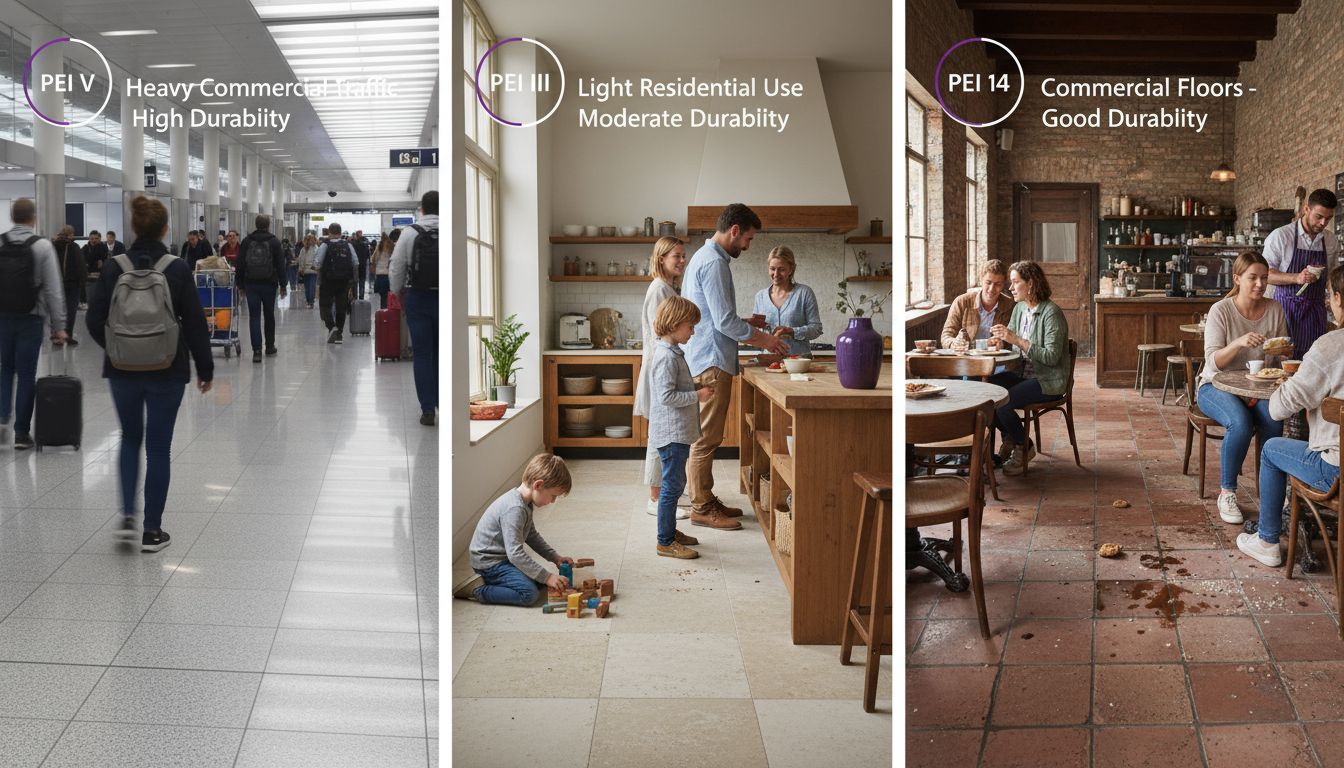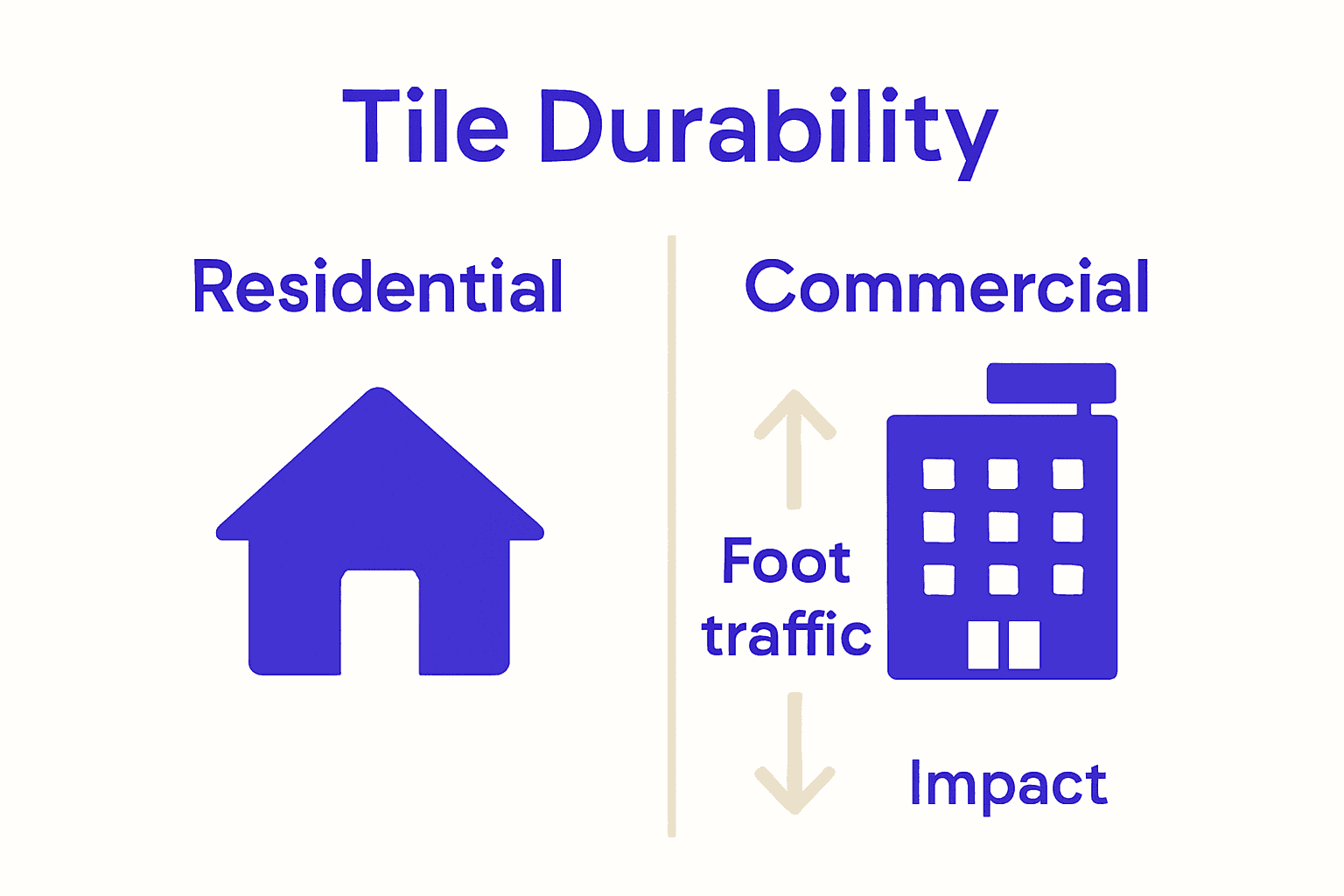Tile Durability Explained: Key Factors and Types
Posted by Mike Belk on Nov 10, 2025

Most people assume every tile offers the same toughness, yet material and manufacturing can make one tile last twice as long as another. Choosing the right tile matters because daily life wears down your floors and walls faster than you might think. This guide clarifies what really defines tile durability and clears up the common myths, equipping you to pick tiles that stay strong and beautiful no matter where you use them.
Table of Contents
- Defining Tile Durability And Common Misconceptions
- Types Of Tile And Their Durability Ratings
- Testing And Grading Systems For Tile Strength
- Practical Applications: Residential Vs. Commercial Use
- Factors That Affect Tile Longevity And Performance
Key Takeaways
| Point | Details |
|---|---|
| Tile Durability is Nuanced | Tile durability varies significantly based on material composition, manufacturing techniques, and intended applications, debunking the myth that all tiles have the same durability. |
| PEI Rating is Essential | Utilizing the Porcelain Enamel Institute (PEI) rating system helps consumers choose tiles suited for specific durability requirements in various environments. |
| Residential vs. Commercial Needs | Tile selection differs greatly between residential and commercial applications due to variations in foot traffic, maintenance routines, and environmental challenges. |
| Multiple Factors Impact Longevity | Key factors such as material quality, installation technique, and ongoing maintenance play critical roles in determining a tile’s long-term performance and durability. |
Defining Tile Durability and Common Misconceptions
Tile durability represents a tile’s capacity to endure daily wear, pressure, and potential damage over extended periods. According to AboutAllFloors, a widespread misconception exists that all tiles possess identical durability characteristics. In reality, material composition and manufacturing processes dramatically influence a tile’s strength and longevity.
Understanding tile durability involves recognizing multiple critical factors that contribute to a tile’s performance. These factors include:
- Material composition: Different tile materials inherently possess varying resistance levels
- Manufacturing technique: Precision in production impacts structural integrity
- Surface treatment: Protective coatings can enhance wear resistance
- Intended application: Tiles designed for specific environments have tailored durability specifications
Homeowners and designers frequently misunderstand durability as a singular, universal attribute. In truth, durability is nuanced and context-dependent. A tile’s resilience varies based on its intended use environment, whether it’s a high-traffic commercial corridor, a residential kitchen, or an outdoor patio. Understanding the Difference Between Porcelain and Ceramic Tile can help clarify these subtle yet significant distinctions in tile performance.
Professional tile selection demands a comprehensive evaluation beyond surface-level aesthetics. Factors like moisture exposure, expected foot traffic, potential impact risks, and maintenance requirements all play crucial roles in determining a tile’s true durability. By understanding these elements, you can make informed decisions that ensure your tile investment remains beautiful and functional for years to come.
Types of Tile and Their Durability Ratings
Tile durability varies significantly across different materials, with each type offering unique performance characteristics. According to USITC, the Porcelain Enamel Institute (PEI) rating system provides a standardized method for classifying ceramic tiles based on their surface abrasion resistance, helping consumers select tiles that match their specific durability requirements.
Key tile types and their typical durability ratings include:
Here’s a comparison of common tile types and their typical durability ratings:
| Tile Type | PEI Rating Range | Typical Use Environment | Key Strengths |
|---|---|---|---|
| Ceramic | Class 1-3 | Residential, light commercial | Affordable, versatile |
| Porcelain | Class 3-5 | High-traffic, commercial, outdoor | Dense, water-resistant |
| Natural Stone | Varies | Residential & commercial | Unique look, variable strength |
| Glass | Not rated by PEI | Decorative, backsplashes | Stylish, low impact resistance |
| Quarry | Class 4-5 | Heavy-duty, industrial | Extremely durable, slip-resistant |
- Ceramic Tiles: Generally suitable for low to moderate traffic areas
- Porcelain Tiles: Exceptionally dense and resistant, ideal for high-traffic zones
- Natural Stone Tiles: Varied durability depending on specific stone type
- Glass Tiles: Typically used for decorative purposes with lower impact resistance
- Quarry Tiles: Extremely hard and durable, perfect for commercial environments
Professional tile selection requires understanding the PEI rating scale, which ranges from Class 0 (no foot traffic) to Class 5 (heavy commercial traffic). Which Types of Tile are Best for Kitchen Flooring can provide additional insights into matching tile types with specific environment needs.
The durability of tiles extends beyond surface resistance. Factors like water absorption rate, chemical resistance, and thermal shock tolerance play crucial roles in determining a tile’s long-term performance. Homeowners and designers must consider not just the immediate aesthetic appeal, but the tile’s ability to withstand daily wear, cleaning procedures, and environmental challenges to ensure a lasting and functional surface.

Testing and Grading Systems for Tile Strength
Tile strength evaluation is a complex process involving multiple sophisticated testing methodologies. According to AboutAllFloors, manufacturers assess tile durability through comprehensive testing methods, including the PEI rating for wear resistance and the Mohs scale for scratch hardness, which provide a nuanced understanding of a tile’s overall performance capabilities.
Key testing and grading systems include:
- Porcelain Enamel Institute (PEI) Rating: Measures surface abrasion resistance
- Mohs Hardness Scale: Evaluates material scratch resistance
- Water Absorption Test: Determines tile’s moisture resistance
- Breaking Strength Test: Measures load-bearing capacity
- Thermal Shock Resistance: Assesses ability to withstand temperature variations
Professional tile selection requires understanding these intricate grading systems. What is Ceramic Tile Made Of? can help you comprehend how material composition directly influences these critical strength measurements. Manufacturers use these standardized tests to provide consumers with reliable indicators of a tile’s potential performance in various environments.
Beyond standard laboratory testing, real-world performance remains the ultimate durability benchmark. Tiles must withstand daily wear, cleaning chemicals, temperature fluctuations, and potential impacts. Homeowners and designers should view test ratings as valuable guidelines, not absolute guarantees, always considering the specific installation environment and expected usage patterns when making their final tile selection.
Practical Applications: Residential vs. Commercial Use
Tile durability requirements dramatically differ between residential and commercial environments, demanding unique considerations for material selection and performance expectations. The primary distinctions emerge from variations in foot traffic, maintenance protocols, and environmental stressors that each setting presents.
Residential tile applications typically involve:
- Lower traffic volume: Less frequent and intense usage
- Aesthetic priorities: Greater emphasis on visual appeal
- Moderate wear expectations: Standard household activities
- Smaller surface areas: Limited square footage compared to commercial spaces
- Personal maintenance: Individual cleaning and care routines
Which Types of Tile are Best for Kitchen Flooring can provide additional insights into selecting appropriate residential tile solutions. Commercial environments, by contrast, demand substantially more rigorous tile performance, with considerations including extreme foot traffic, heavy equipment movement, and stringent cleaning protocols.

Commercial tile applications require specialized durability considerations such as enhanced impact resistance, chemical tolerance, and consistent performance under prolonged stress. Spaces like hospitals, restaurants, airports, and industrial facilities need tiles that can withstand constant use, frequent cleaning with harsh chemicals, and significant mechanical stress. Homeowners and commercial designers must carefully evaluate tile specifications, understanding that durability isn’t a one-size-fits-all characteristic but a nuanced selection process tailored to specific environmental demands.
Factors That Affect Tile Longevity and Performance
Tile performance is a complex interplay of multiple critical factors that determine its long-term durability and aesthetic appeal. According to AboutAllFloors, tile longevity hinges on several key elements including material composition, manufacturing quality, installation methods, and ongoing maintenance practices.
Key factors impacting tile performance include:
- Material Quality: Inherent strength and composition of tile base material
- Manufacturing Precision: Consistency in production processes
- Installation Technique: Proper substrate preparation and professional mounting
- Surface Treatment: Protective coatings and sealants
- Environmental Exposure: Temperature variations, moisture levels, and chemical interactions
- Maintenance Frequency: Regular cleaning and periodic professional care
What is Tile Sealer? offers additional insights into how protective treatments can significantly extend tile life. Professional installation and strategic maintenance are equally crucial, as even high-quality tiles can deteriorate rapidly under suboptimal conditions.
Understanding these interconnected factors requires a holistic approach to tile selection and care. Homeowners and designers must recognize that tile durability is not a static characteristic but a dynamic result of material science, installation expertise, environmental conditions, and consistent maintenance. By proactively addressing each of these elements, you can maximize the longevity and performance of your tile investments, ensuring beautiful and functional surfaces for years to come.
Choose Durable Tiles Designed to Last
Selecting the right tile means understanding key factors like material quality, PEI rating, and intended use that determine long-term durability and performance. If you want to avoid costly repairs and constant replacements caused by unsuitable tile choices, it is important to focus on how tiles stand up to real-world conditions such as foot traffic, moisture, and impact. At BELK Tile, we recognize that durability goes beyond appearances. Our extensive collection lets you choose from porcelain, ceramic, natural stone, and more—all with detailed specifications to match your unique needs.
Discover tiles that combine style and strength for your home or business by exploring our wide tile selection. Whether you need kitchen backsplash tiles, durable commercial flooring, or decorative glass mosaics, we provide easy browsing with clear specs and expert support. Don’t settle for less when it comes to lasting quality. Visit BELK Tile now to find the perfect tile that stands up to everyday demands and elevates your space.
Frequently Asked Questions
What factors determine tile durability?
Tile durability is influenced by material composition, manufacturing techniques, surface treatments, and intended applications. These factors combined dictate how a tile performs under daily wear and environmental conditions.
How do different types of tiles compare in durability?
Tiles vary in durability based on their type. For instance, porcelain tiles are denser and offer higher resistance, making them suitable for high-traffic areas, whereas ceramic tiles are generally more suitable for light use in residential settings.
What is the PEI rating, and why is it important?
The Porcelain Enamel Institute (PEI) rating measures the surface abrasion resistance of ceramic tiles, helping consumers choose tiles based on their durability needs. The rating ranges from Class 0 (no traffic) to Class 5 (heavy commercial traffic).
How can proper maintenance extend the life of tiles?
Regular cleaning and the application of protective treatments or sealants can significantly enhance tile longevity. Additionally, professional installation and addressing environmental factors like moisture exposure help maintain tile performance over time.



